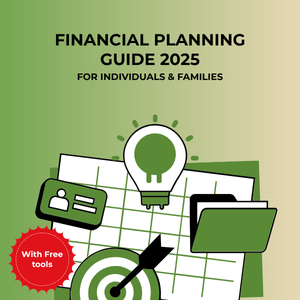Financial Planning Guide 2025
Chapter 2

Q1. Where do you stand today?
The first step in accomplishing anything of importance is to assess your current position and your desired outcome after a specific period. To do this, you first need to evaluate your financial health and then determine how your money is being managed.
Measuring your financial health: To effectively manage your finances, it’s essential to start by assessing your current financial health. Generally, most of us get a complete physical health check-up once a year, especially after a certain age. This is done to identify any potential health issues and treat them before they cause harm. Your finances are as important to you as your health, and deserve at least the same amount of care and attention.
Here, we will cover three simple personal finance rules that you can start with to see where you stand today.
- Debt-to-Income Ratio: The debt-to-income ratio is a personal finance measure that compares an individual’s debt payments to their income. Ideally, your debt-to-income ratio should not exceed 30%, as this indicates that you are straining your income. This means you should not be spending more than 30% of your income on paying loans/interest on loans.
- Savings-to-Income Ratio: The Savings-to-Income Ratio indicates the percentage of an individual’s income that is set aside for future goals. You should be saving at least 20% of your monthly income to save and invest.
- Contingency Reserve: Contingency Reserve is a part of retained earnings that is set aside for potential future losses. You should set aside 6 to 24 months of living expenses as a contingency fund to be used only in times of emergency. This should include any EMIs that you may have.
Once you implement these simple rules, you will find that your finances are more manageable and under your control.
How your money moves: Broadly, you have four crucial financial quadrants, i.e., incomes, expenses, assets, and liabilities. Money tends to flow between these four quadrants. Your income will cover your costs and help you afford the purchase of any assets you may acquire, whether in whole or in part. Part of the purchase of assets can be supported by taking on liabilities. Your liability payments are, in turn, again funded by your income.
Thus, the most crucial way to generate wealth is to live within or, preferably, below your means by keeping a close eye on your money flow. To achieve this, you first need to be aware of what your goals are and what you are spending your money on.
Page 4 ( Previous )
Follow-up Pages
Use the tabs below to navigate between pages
New NPS Rule: What does it mean for your retirement plan?
If you’ve chosen the NPS route for your retirement savings, the recent change to [...]
EPFO 2025: The Crucial New Rules shaping your financial plan.
TL;DR The article emphasizes the significance of the Employee Provident Fund (EPF) as an indispensable [...]
Rethinking Your Emergency Fund – An essential aspect of your financial plan
TL;DR This article emphasizes the importance of a clearly defined, organized emergency fund for [...]





